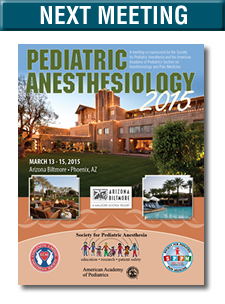ASA meeting reviews
Pediatric Adenotonsillectomy: Enhancing Quality and Efficiency; Ensuring Safety
By Cheryl K. Gooden, MD
Mount Sinai Medical Center
The Sunday morning panel moderated by Lynne Maxwell, MD (Children’s Hospital of Philadelphia) provided an overview of recent advances from preoperative assessment through postoperative management of the pediatric patient with obstructive sleep apnea syndrome (OSAS). The first speaker Deborah Schwengel, MD (Johns Hopkins Children’s Center) presented “Preoperative Assessment and Decision-Making.” She began by emphasizing the fact that OSAS is a multisystem disorder. It is not simply a disorder observed in the overweight/obese patient. Rather, there is a broad spectrum of patients that may present with OSAS.
Dr. Schwengel highlighted the fact that approximately 530,000 adenotonsillectomies (AT) are performed annually in the USA. AT improves, but does not necessarily resolve, OSAS in some children. Although uncommon, mortality or morbidity can occur from OSAS or AT.
She suggested that there is room for improvement with regards to screening of children for the diagnosis of OSAS. Of particular note, polysomnography (PSG) is not a perfect test. She stated that there are several issues of concern related to the use of PSG as a screening tool. First, PSG is an expensive study, and it is not available in all medical centers. Second, PSG is not always accurate. Finally, PSG can be scored differently in different centers. That said, PSG still remains the gold standard, but it is not necessary to perform in every patient.
Dr. Schwengel concluded her presentation with a discussion of the need to assess our patients for markers of clinical suspicion of OSA. The clinical suspicion includes both signs and symptoms of OSA. Some examples are obesity, underweight, neck circumference, snoring, witnessed apnea, and behavioral problems.
Ronald S. Litman, DO (Children’s Hospital of Philadelphia) presented “Intraoperative Strategies to Ensure Postoperative Safety and Efficient PACU Stay.” Dr. Litman began by posing several questions to the audience related to intraoperative management for AT. Some of his questions included:
-
Would you use a laryngeal mask airway (LMA) or endotracheal tube (ETT)?
-
Would you use a neuromuscular blocker (NMB) agent?
-
Extubate – awake, deep, or in the PACU?
He highlighted the potential advantages of LMAs, such as less oxygen desaturation, less severe pain, and avoidance of NMBs. There are several studies to suggest that higher pain scores are observed with the use of an ETT in AT procedures. He reviewed factors that promote upper airway collapse, including use of opioids, residual volatile agent, residual paralysis, and airway edema.
Dr. Litman concluded his presentation with focus on the safest analgesic for AT. When posed as a question, there is no clear-cut answer. What we do know, based on Dr. Karen Brown’s (Montreal Children’s Hospital) study, is that children with longstanding hypoxemia need less opioid. On a final note, Dr. Litman recommended the use of dexamethasone in AT procedures, for several reasons:
-
Decreases postoperative nausea and vomiting
-
Decreases pain
-
Decreases time to oral intake.
The final speaker in this panel was Kimmo Murto, MD (Children’s Hospital of Eastern Ontario) who presented “Choosing Safe Postoperative pain Management, in the Hospital and at Home.” He explored the pain profile post-AT. He indicated that prolonged pain tends to be the problem that is observed. However, the pain may present as static or dynamic. The use of codeine for postoperative AT pain is best avoided, due to the possibility of toxicity occurring in some patients. Overall, the risk of death following AT is 1:15,000 – 30,000. He recommended a recent article on the topic of AT.1 Dr. Murto suggested that initial pain management should include around the clock dosing for postoperative analgesia following AT.
Reference
-
Brown KA, Brouillette RT. The elephant in the room: lethal apnea at home after
adenotonsillectomy. Anesth Analg 2014;118:1157-9.



